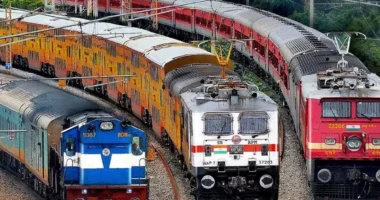The Indian Railways has embarked on a commendable mission to safeguard one of India’s most treasured national assets: the endangered Gir Lions. This bold initiative involves rescheduling train timings, demonstrating a union of environmental stewardship and infrastructural adaptation. As this issue garners global attention, let’s delve into the significant implications, motivations, and aspirations of such a vital endeavor.
## Understanding the Crisis
### The Plight of the Gir Lions
Found exclusively in the Gir Forests of Gujarat, the Asiatic lions are a symbol of India’s ecological diversity and heritage. Despite their regal status, these majestic creatures are beleaguered by numerous challenges:
– **Habitat Loss**
– **Human-Wildlife Conflict**
– **Poaching**
However, a grave danger lurks in an unexpected quarters – the railway tracks that intersect their natural habitat.
### Train Collisions: An Alarming Statistic
Historically, the railway lines crisscrossing the Gir Forest have cast a shadow of peril over the lion population. Data indicates a worrying trend:
– Increased incidents of train-lion collisions.
– Unsustainable mortality rates threatening species conservation.
The confluence of these circumstances necessitated immediate action, catalyzing the Indian Railways to formulate an ingenious strategy.
## Indian Railways to the Rescue
### Rescheduling Train Timings
In a bid to mitigate the threat, Indian Railways has adopted an eco-centric and innovative approach — rescheduling train operations, ensuring minimal wildlife interference.
#### Key Details of the Initiative:
– **Timely Adjustments**: Trains will now run during **non-peak lion activity hours**, significantly reducing the possibility of collisions.
– **Speed Restrictions**: Implementing speed restrictions in sensitive zones further cushions the impact of any untoward events.
– **Enhanced Monitoring**: Collaboration with local forest authorities for real-time tracking and data sharing.
### Collaborative Efforts
This initiative is not a solo endeavor; it draws strength from collaborative ventures, bringing together various stakeholders:
#### Forest Departments
– **Joint Patrolling**: Coordinated efforts to monitor railways adjacent to the protected areas.
– **Data Collection**: Utilizing technology for tracking lion movements and adjusting operational tactics accordingly.
#### Environmental Organizations
– **Campaigns and Advocacy**: Raising awareness about the symbiotic relationship between sustainable development and wildlife conservation.
– **Research and Development**: Engaging in studies to bolster lion protection measures.
## The Environmental and Economic Implications
### Protecting Ecosystems
The rescheduling project is a beacon of hope for the delicate ecosystems within Gir:
– **Habitat Preservation**: Reduced disturbances ensure the sustaining of biodiversity.
– **Enhanced Ecosystem Health**: Mitigation of risks associated with train operations stabilizes the local ecological balance.
### Socio-Economic Benefits
Beyond securing the wildlife, this initiative contributes to socio-economic dimensions:
#### Tourism Boost
The Gir lions are intrinsic to Gujarat’s tourism allure. Their thriving population translates to:
– **Increased Revenue**: A boost in tourism inevitably leads to an economic surge.
– **Local Employment**: Ecotourism provides livelihoods, supporting local communities.
#### National and Global Recognition
The Indian Railways’ proactive stance is a testament to a conscientious alignment of technological prowess with conservation goals, earning accolades as a global model for biodiversity safeguarding.
## Challenges and Opportunities
### Challenges
Despite its ambitious scope, the initiative faces a gamut of challenges:
– **Operational Complexities**: Rescheduling can lead to logistical challenges for freight and passenger schedules.
– **Fiscal Constraints**: Funding for comprehensive measures, like infrastructure modifications, is substantial.
### Opportunities
Nevertheless, these challenges herald opportunities for groundbreaking solutions:
– **Innovation in Rail Technology**: Development of wildlife-friendly rail technologies can address safety concerns.
– **Enhanced Conservation Strategies**: Strengthening policies and frameworks to ensure sustainable coexistence.
## Conclusion
The rescheduling of train timings by Indian Railways to protect the endangered Gir lions exemplifies a harmonious blend of development and ecology. Through collaborative effort and an unwavering commitment to sustainability, the move promises a brighter future, where human progress proceeds in tandem with environmental preservation. With perseverance and a unified vision, India sets a precedent in showcasing that progress does not necessitate a compromise on natural heritage.
As we look forward, it is imperative that similar proactive strategies be adopted across regions confronting analogous circumstances. By doing so, we create a world that treasures and protects its natural inhabitants, underlining the belief that compassion and conservation form the backbone of progress.






